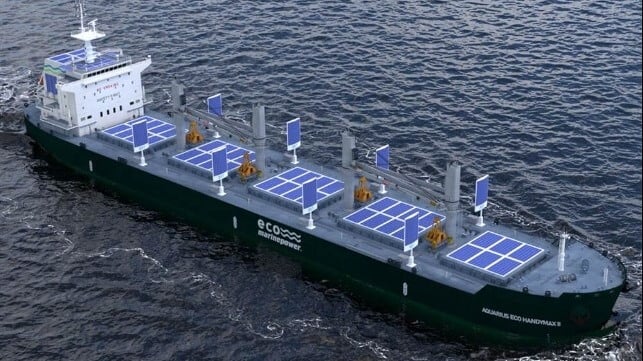Zero-Emission Bulker Concept Uses Sails, Fuel Cells, Solar Power

Japan’s Eco Marine Power has expanded on its earlier research presenting its first design concept for a zero-emission Handymax bulker building on the previous design for a low emission vessel. The design is being developed within the framework of the Eco Marine Power Research Institute, which includes participation from StarBulk and ZEABORN Ship Management, among others.
Known as the Aquarius Eco Handymax II, the design incorporates a range of renewable energy solutions, energy-saving devices, electric propulsion, and fuel cells. According to Eco Marine, all the technologies encompassed in the design are either currently available or under development. Further, they plan to test elements of the design on an in-service Handymax bulker later this year.
“The Aquarius Eco Handymax is the result of years of research & development including shore-based and ship-based trials,” said Greg Atkinson, President & Chief Technology Officer at Eco Marine Power. “The design focus is not on any one solution or technology, however, but rather how various alternative power sources and energy saving devices can work together to achieve the zero-emissions operation of a large ship.”
The Aquarius Eco Handymax II ship design includes the integrated sail-assisted propulsion and solar power system known as Aquarius Marine Renewable Energy, previously developed by Eco Marine. The system, which received Approval in Principle from ClassNK in 2021, integrates rigid sails, marine-grade solar panels, energy storage modules, a charging system, and marine computers that enable the ship to tap into renewable energy by harnessing the power provided by the wind and sun. The array of rigid sails is automatically positioned by a computer system to best suit the prevailing weather conditions and can be lowered and stored when not in use or during bad weather. Eco Marine recently applied for additional patents on this system.
The first Aquarius Eco Handymax design previously presented is a low emission ship. It combines low emission main engines with the Aquarius MRE and other energy-saving devices. Eco Marine has added a further range of energy-saving devices, including an air lubrication system along with electric propulsion and fuel cells to create the zero-emission bulker concept.
Additional at sea trials will be undertaken later this year. The goal is to evaluate the performance of the energy-saving devices in cooperation with the ship’s owner and other strategic partners from the institute.
